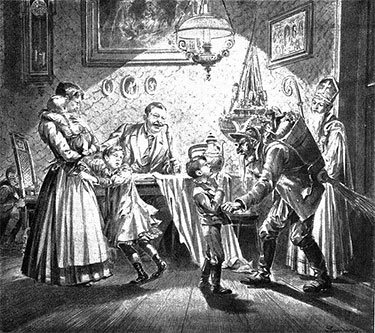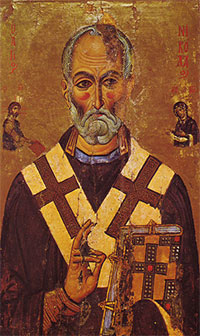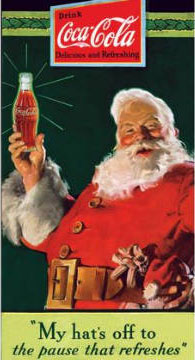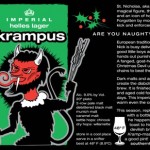A kinder, gentler Christmas

Krampus and Saint Nicholas visit a Viennese home in 1896. Pick one. Illustration: Wiener Bilder, June 12, 1896
We are fortunate to live in a kinder gentler era, where the worst a naughty child can expect of Christmas is a gift of fossil fuel, instead of an Xbox. Children of earlier times might look forward to Christmas with the dread normally reserved for Judgment Day.
As evidence, I submit Krampus, the Christmas Devil of the Alpine region, who stuffs the naughty into his sack and bears them off to his hidden lair, where he treats them to drowning, eating, or transport to Hell. Krampus can be recognized by his horns, demonic demeanor, chains, bells, and a bundle of birch switches, suitable for a good flogging. Ya better watch out.
St. Nick himself was not always a “jolly old elf.” The lump of coal gift is a holdover from his reputation of being hard on the naughty. The range of possible punishments was once larger. According to a Wikipedia article on the Dutch version of Santa’s little helper, Zwarte Piet (Black Peter), the saint had “often been presented as a bogeyman when he was still a solitary character.” Black Peter and Krampus took on the darker attributes of Santa, a character who, some say, had his origins in Norse Mythology:
“According to Hélène Adeline Guerber, and many others, the origin of Sinterklaas and his helpers can probably be found in the Wild Hunt of Wodan [Odin]. Riding the white horse Sleipnir he flew through the air as the leader of the Wild Hunt. He was always accompanied by two black ravens, Huginn and Muninn.Those helpers would listen, just like Zwarte Piet, at the chimney – which was just a hole in the roof at that time – to tell Wodan about the good and bad behaviour of the mortals.” Wikipedia (Black_Peter)
St. Nicholas has come a long way from the 4th centuty Greek bishop who attended the Council of Nicaea. According to the tale, he built up his good-guy credentials with this act:
“…during a terrible famine, a malicious butcher lured three little children into his house, where he killed them, placing their remains in a barrel to cure, planning to sell them off as ham. Saint Nicholas, visiting the region to care for the hungry, not only saw through the butcher’s horrific crime but also resurrected the three boys from the barrel by his prayers.”
And in this story about a poor man who had no dowry for his three daughters:
“Hearing of the girls’ plight, Nicholas decided to help them, but being too modest to help the family in public (or to save them the humiliation of accepting charity), he went to the house under the cover of night and threw three purses (one for each daughter) filled with gold coins through the window opening into the house.” Wikipedia (Saint_Nicholas)
But the modern day icon of St. Nicholas comes to us through the Dutch settlement of New York. The white beard probably comes from depictions of Odin, the red hat was originally a bishop’s miter (still preserved in the Father Christmas imagery of St. Nick). His flying sleigh (often depicted in the Netherlands drawn by a goat) probably also comes from the flying horse Sleipnir.
The jolly roly-poly man all clad in red and white, with rosy cheeks and a twinkle in his eye is an American overlay, and owes a lot to an artist working for the Coca-Cola company. According to a cola executive quoted in Eatocracy:
“Coca-Cola had an artist named Haddon Sundblom who worked for us from 1931 to 1964. Each year he would create an advertising piece that would show Coca-Cola and Santa Claus, and because the ads appeared in all of the popular magazines of the day, his interpretation became the American vision of what Santa Claus looked like.”
Krampus, fortunately, was left behind in the Old Country–although he has made an advertising appearance on the label of a beer now produced by Southern Tier Brewing Company in Lakewood, NY. They report that Krampus Imperial Helles Lager is their bitterest brew.
Tags: listeningpost











My encounter with Krampus came in Bregenz, Austria, in December of 1965, and even at the ripe old age of twenty I was pretty darned scared of him! St. Nicholas was keeping Krampus at bay, but I would still flinch when he rattled his heavy chain or waved a small bag of coal in my direction, snarling some sort of unintelligible threat. Thankfully I must have been good enough and was left holding a lovely tree ornament in the likeness of the good saint himself. That ornament still resides on my yearly Christmas tree, a tree lit with electric lights instead of the candles on that Austrian evergreen.
Thanks for the memories, and a very happy and healthy holiday season to you and yours, Dale.
Krampus is invading the holidays in the form of retailers demanding we go broke shopping from Black Thursday right up to Christmas.
Krampus made an appearance last week in an episode of “Grimm.”
It always seemed to me that Sankt Nicolas {San(k)t (N)i_c(o)las} is related etomologically to Santa Claus. Interesting history and observations, Dale.